Introduction to Digital Marketing
In today’s world, almost every business wants to be visible online, connect with its audience, and drive sales efficiently. This is where Digital Marketing comes into play. Unlike traditional marketing, which depends on newspapers, billboards, or television, Digital Marketing (also known as Online Marketing, Internet Marketing, Web Marketing, or Electronic Marketing) uses digital channels like websites, search engines, social media, email, and mobile apps to promote products and services.
With the rise of smartphones and high-speed internet, Online Marketing has become one of the most effective ways to reach targeted customers. Whether it’s a small local store or a global corporation, Digital Marketing strategies allow businesses to reach millions of potential customers in a cost-effective and measurable way.
According to recent studies, businesses that invest in Internet Marketing and Social Media Marketing experience faster brand growth compared to those relying only on offline promotions. This is because Digital Marketing provides direct interaction with customers, real-time feedback, performance tracking, and much higher flexibility than traditional methods.
In simple words, Digital Marketing = Right message + Right audience + Right time, through digital channels.
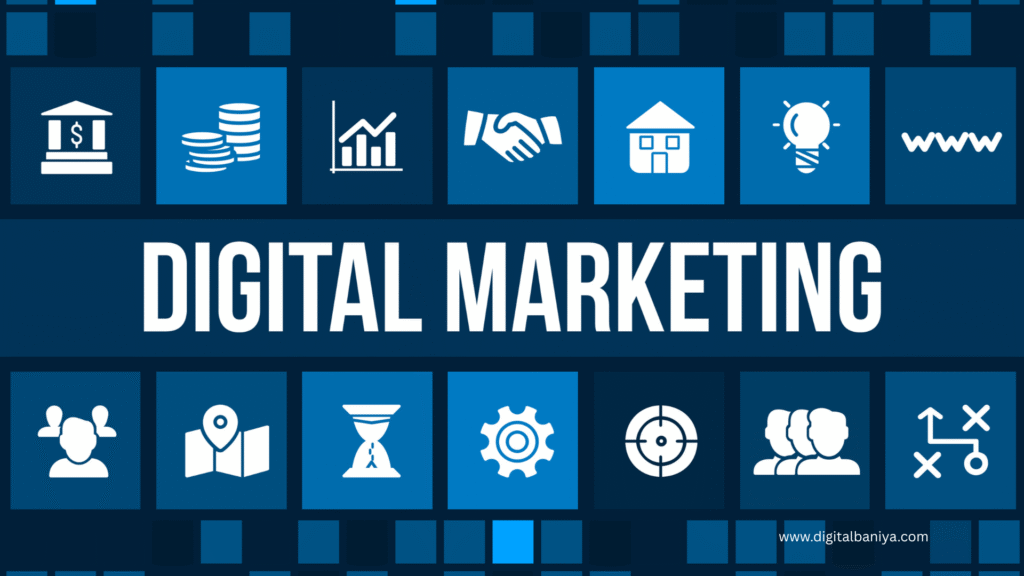
What is Digital Marketing?
Digital Marketing is the process of promoting products, services, or brands using digital platforms like search engines, websites, social media, email, and mobile apps. It is often interchangeably called Online Marketing, Internet Marketing, Web Marketing, or Electronic Marketing because all these terms describe the same concept: using the internet and digital tools for marketing.
At its core, Digital Marketing is about connecting with your audience where they spend most of their time—online.
Some experts also call it Interactive Marketing because it allows two-way communication between businesses and customers. For example, when a brand posts on Instagram, customers can like, comment, share, or even directly purchase through that post. This interaction builds stronger relationships and trust.
Why is Digital Marketing Important?
- Massive Reach: With billions of internet users worldwide, Internet Marketing gives access to a global audience.
- Cost Effective: Unlike traditional advertising, Digital Marketing strategies like Content Marketing and Search Marketing are affordable even for small businesses.
- Targeted Campaigns: Businesses can target audiences based on demographics, location, interests, or even behaviors.
- Measurable Results: With Performance Marketing, businesses can track every click, impression, and conversion in real time.
- Adaptability: From Mobile Marketing to Social Media Marketing, businesses can easily adapt their campaigns as trends change.
Key Characteristics of Digital Marketing
- Multi-channel approach: Includes Content Marketing, Search Marketing, Social Media Marketing, Mobile Marketing, and Interactive Marketing.
- Data-driven decisions: Every campaign can be tracked and optimized for better performance.
- Customer-focused: Unlike traditional ads, Web Marketing focuses on engaging customers and providing value.
- Scalable: Works for startups as well as large corporations.
Types of Digital Marketing
Digital Marketing is not just one technique—it’s a combination of multiple strategies that work together to build a brand, attract customers, and generate revenue. Businesses can choose the right type of Online Marketing depending on their goals, audience, and budget.
Below are the most important types of Digital Marketing that every business should know:
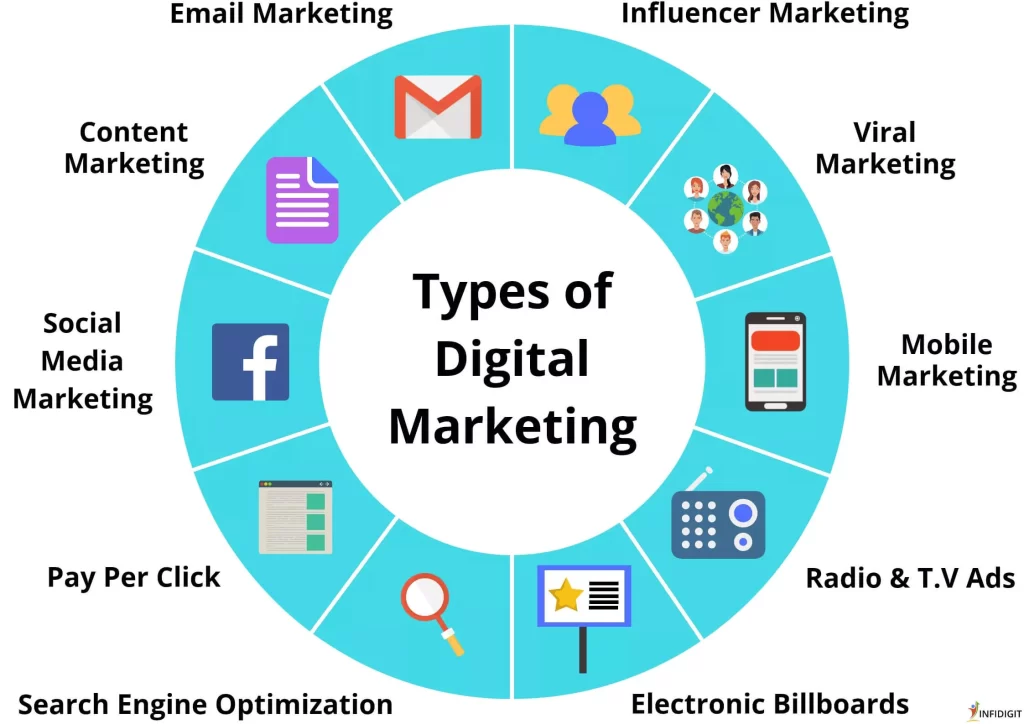
1. Content Marketing
Content Marketing is one of the most powerful forms of Digital Marketing. It focuses on creating and distributing valuable, relevant, and consistent content to attract and engage a clearly defined audience. Instead of directly promoting a product, this strategy provides useful information that builds trust and authority.
- Examples of Content Marketing:
- Blog posts and articles
- E-books and whitepapers
- Infographics
- Podcasts
- Videos and webinars
- Benefits:
- Improves SEO and ranking on search engines
- Builds brand authority and trust
- Drives long-term organic traffic
In today’s digital era, Content Marketing is often combined with Search Marketing and Social Media Marketing to maximize reach.
2. Search Marketing (SEO & SEM)
Search Marketing is the backbone of Online Marketing. It ensures that your business appears in front of people actively searching for your products or services.
It is divided into two main categories:
- SEO (Search Engine Optimization): Optimizing websites and content to rank organically on Google.
- SEM (Search Engine Marketing): Running paid ads (Google Ads, Bing Ads) to appear in search results instantly.
- Benefits of Search Marketing:
- Brings targeted traffic
- Higher conversion rates
- Builds online visibility
For example, when someone searches “best mobile phones,” companies running Search Marketing campaigns can appear right on the first page, whether through organic SEO or paid SEM.
3. Social Media Marketing (SMM)
Social Media Marketing has transformed how brands connect with their audiences. With billions of people using Facebook, Instagram, LinkedIn, Twitter (X), and TikTok, businesses can use these platforms to promote products, run ads, and interact directly with customers.
- Examples of Social Media Marketing:
- Organic posts and engagement
- Paid ads and influencer partnerships
- Social media contests and campaigns
- Benefits:
- Builds brand awareness quickly
- Provides direct customer interaction
- Supports both Performance Marketing and Interactive Marketing strategies
Social media platforms also support Mobile Marketing, since most users access them through smartphones.
4. Mobile Marketing
With the majority of internet traffic now coming from smartphones, Mobile Marketing has become a crucial part of Digital Marketing. It focuses on reaching customers via mobile devices using SMS, push notifications, in-app ads, and mobile-friendly websites.
- Examples of Mobile Marketing:
- SMS promotions
- In-app advertisements
- Mobile-optimized websites and apps
- WhatsApp and Telegram marketing
- Benefits:
- Real-time communication with customers
- Highly personalized campaigns
- Cost-effective reach
Mobile Marketing is closely connected to Interactive Marketing, since it allows businesses to engage with users through mobile apps, chatbots, and direct messaging.
5. Performance Marketing
Performance Marketing is a results-driven approach to Digital Marketing. Businesses only pay for specific actions like clicks, leads, or sales. It’s highly measurable and is often linked with affiliate marketing, pay-per-click ads, and influencer marketing.
- Examples of Performance Marketing:
- Pay-Per-Click (PPC) campaigns
- Affiliate marketing programs
- Influencer campaigns with performance tracking
- Benefits:
- Businesses pay only for results
- Easy to measure ROI
- Highly scalable campaigns
This is especially important for businesses with limited budgets, since Performance Marketing allows them to maximize results without overspending.
6. Interactive Marketing
Unlike traditional ads, Interactive Marketing focuses on creating two-way communication between businesses and customers. Instead of passively showing ads, it encourages users to engage with the brand.
- Examples of Interactive Marketing:
- Polls, quizzes, and surveys
- Interactive infographics and calculators
- Chatbots and virtual assistants
- Personalized product recommendations
- Benefits:
- Boosts customer engagement
- Builds strong customer relationships
- Provides valuable customer insights
Interactive strategies are often combined with Social Media Marketing and Content Marketing to make campaigns more engaging.
7. Email & Web Marketing
Email Marketing and Web Marketing are often considered the oldest but still most effective forms of Electronic Marketing. Businesses send newsletters, promotions, and personalized offers directly to customers’ inboxes or use websites as digital storefronts.
- Examples:
- Weekly newsletters
- Automated email sequences
- Website promotions and banners
- Benefits:
- Direct communication with customers
- Builds long-term relationships
- Drives traffic to websites and online stores
Conclusion
All these types of Digital Marketing—from Content Marketing to Performance Marketing, Social Media Marketing, Search Marketing, Mobile Marketing, and Interactive Marketing—work best when combined into a unified strategy. Each type has unique strengths, but together they help businesses build visibility, attract customers, and increase sales.
Benefits of Digital Marketing
In today’s fast-paced digital world, Digital Marketing has become the backbone of business growth. Unlike traditional advertising, Online Marketing gives businesses the power to reach a wider audience, track performance, and optimize campaigns in real time. Whether it’s a small startup or a global enterprise, the advantages of Internet Marketing are undeniable.

1. Cost-Effective Compared to Traditional Marketing
One of the biggest benefits of Digital Marketing is cost efficiency. Running TV or print ads requires huge budgets, but Online Marketing platforms like Google Ads, Facebook Ads, and Email Campaigns allow businesses to start even with small investments.
- Performance Marketing ensures that companies only pay for results such as clicks, leads, or sales.
- Content Marketing provides long-term organic traffic at a fraction of the cost of offline ads.
This makes Electronic Marketing highly accessible to businesses of all sizes.
2. Global Reach with Local Targeting
Traditional marketing has geographical limits, but Web Marketing enables businesses to reach customers globally. At the same time, features like geo-targeting allow brands to focus only on specific cities, regions, or even neighborhoods.
- For example, a local grocery store can run Social Media Marketing campaigns targeting people within 10 km of its location.
- A global e-commerce business can use Search Marketing to attract international customers.
This combination of global exposure and local precision is what makes Digital Marketing unique.
3. Measurable Results and Analytics
With traditional advertising, measuring ROI is difficult. But Digital Marketing provides accurate insights into how campaigns are performing.
- Search Marketing tools like Google Analytics track user behavior.
- Performance Marketing dashboards show clicks, impressions, conversions, and revenue.
- Social Media Marketing analytics reveal engagement, reach, and customer sentiment.
This data-driven approach helps businesses refine strategies and invest only in what works.
4. Enhanced Customer Engagement
Interactive Marketing ensures that businesses don’t just talk to customers but also talk with them. Unlike one-way traditional ads, Digital Marketing encourages two-way communication.
- Social Media Marketing allows brands to interact through comments, polls, and live sessions.
- Mobile Marketing engages customers with personalized messages, push notifications, and app-based offers.
- Content Marketing educates customers, building trust and long-term relationships.
Engaged customers are more likely to convert and remain loyal to a brand.
5. Personalization and Better Targeting
Modern Internet Marketing tools use data to deliver highly personalized experiences. Businesses can segment audiences based on demographics, interests, and online behavior.
- Email Marketing can send personalized product recommendations.
- Social Media Marketing can retarget users who previously visited the website.
- Performance Marketing ensures ad budgets are spent only on high-intent users.
This level of personalization increases conversion rates and customer satisfaction.
6. Boosts Brand Awareness and Credibility
Digital Marketing allows even small businesses to build a strong brand presence. With the right mix of Content Marketing, Search Marketing, and Social Media Marketing, companies can establish themselves as industry leaders.
- High-ranking websites (SEO) build trust.
- Active Web Marketing through blogs and videos increases visibility.
- Interactive Marketing builds credibility by engaging customers in meaningful conversations.
As customers trust brands more, they’re more likely to purchase from them.
7. Higher Conversion Rates and ROI
Every business wants better returns on investment, and Digital Marketing makes it possible.
- Search Marketing brings in high-intent users who are ready to buy.
- Performance Marketing ensures you pay only for valuable actions.
- Mobile Marketing reaches customers instantly, improving response rates.
With real-time optimization, businesses can continuously improve performance and maximize ROI.
8. Flexibility and Scalability
Another great advantage of Digital Marketing is flexibility. Businesses can start small and scale up as results improve. Campaigns can be paused, adjusted, or expanded at any time.
For instance:
- A startup may begin with Content Marketing and Social Media Marketing.
- As they grow, they can add Performance Marketing and Mobile Marketing strategies.
This adaptability makes Electronic Marketing perfect for fast-changing markets.
Conclusion
The benefits of Digital Marketing go far beyond cost savings—it provides global reach, measurable results, customer engagement, personalization, higher ROI, and long-term growth. By integrating strategies like Search Marketing, Social Media Marketing, Content Marketing, Mobile Marketing, Interactive Marketing, and Performance Marketing, businesses can stay ahead of competitors in the digital-first world.
Digital Marketing vs Traditional Marketing
Marketing has always been the foundation of every business. Earlier, businesses relied heavily on traditional marketing methods like TV ads, radio, billboards, and newspapers. But with the rise of the internet, Digital Marketing has become the new norm. Both have their advantages, but in today’s competitive world, Online Marketing is leading the way.
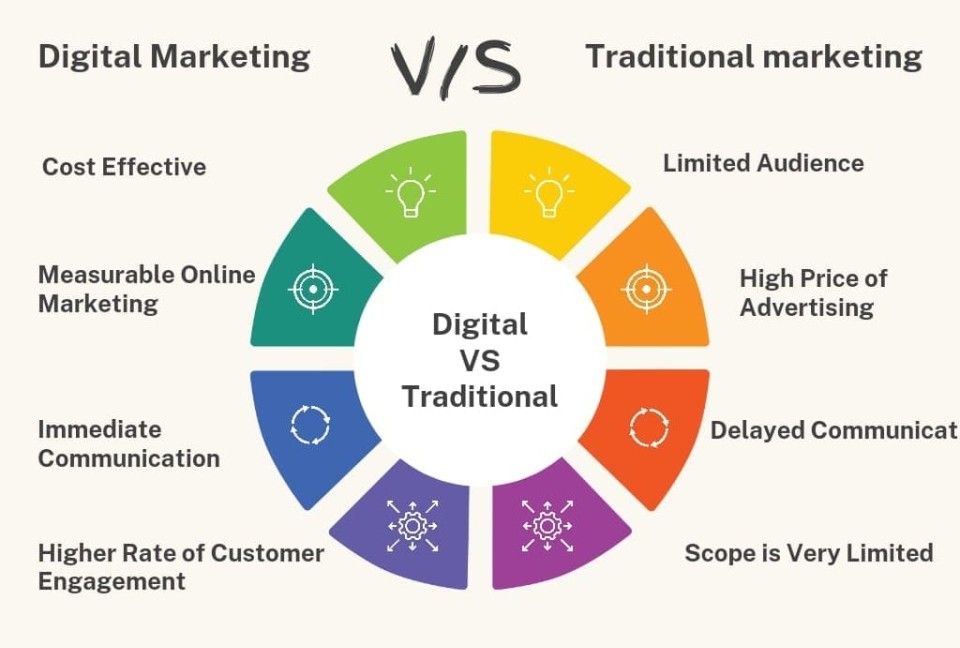
1. Audience Reach
- Traditional Marketing:
TV, radio, and print ads reach a broad audience, but there is no guarantee that the right target market is reached. - Digital Marketing:
With Internet Marketing tools, businesses can target customers by age, location, interests, and online behavior. This ensures maximum efficiency.
Example: A clothing brand can use Social Media Marketing to reach only young adults in metro cities, unlike a newspaper ad that reaches everyone.
2. Cost-Effectiveness
- Traditional Marketing:
Running TV commercials or large billboards requires massive budgets. - Digital Marketing:
Strategies like Performance Marketing, Content Marketing, and Search Marketing allow even small businesses to compete with big brands. You can start with as little as a few hundred rupees.
Example: A start up can run Mobile Marketing campaigns at a fraction of the cost of a radio advertisement.
3. Measurability
- Traditional Marketing:
It’s almost impossible to measure how many people actually saw a TV or newspaper ad. - Digital Marketing:
Every click, impression, and conversion can be tracked in real time with analytics tools. Performance Marketing ensures that businesses only pay for results.
Example: A Google Ads campaign under Search Marketing can tell you exactly how many people searched for your product and clicked on your ad.
4. Customer Engagement
- Traditional Marketing:
One-way communication. Businesses talk to customers, but customers can’t respond. - Digital Marketing:
Two-way communication through Interactive Marketing, Social Media Marketing, and Content Marketing. Customers can like, comment, share, or even message businesses directly.
Example: Brands using Instagram polls (part of Interactive Marketing) create stronger connections than static print ads.
5. Personalization
- Traditional Marketing:
Everyone sees the same TV ad or newspaper promotion—no personalization. - Digital Marketing:
With Web Marketing and Electronic Marketing, brands can deliver highly personalized messages. From personalized emails to retargeting ads, every customer feels unique.
Example: An e-commerce site can show personalized product recommendations using Mobile Marketing and Email Marketing.
6. Speed and Flexibility
- Traditional Marketing:
Creating and running ads in newspapers or TV requires a lot of time and effort. - Digital Marketing:
Campaigns can be launched instantly and adjusted anytime. If a Social Media Marketing post is not performing well, it can be edited or boosted within minutes.
7. Return on Investment (ROI)
- Traditional Marketing:
Hard to measure ROI, and usually costs are very high. - Digital Marketing:
ROI is measurable and generally higher. Performance Marketing ensures businesses pay only when specific goals are achieved—like leads, sales, or app downloads.
8. Accessibility for Small Businesses
- Traditional Marketing:
Usually dominated by large corporations with massive budgets. - Digital Marketing:
Levels the playing field. Even small businesses can use Online Marketing, Search Marketing, and Social Media Marketing to compete with industry giants.
Conclusion
While traditional marketing still has its place, the future clearly belongs to Digital Marketing. Its ability to provide measurable results, cost efficiency, customer engagement, personalization, and global reach makes it the most powerful form of marketing today. Whether it’s Content Marketing, Mobile Marketing, Performance Marketing, or Social Media Marketing, businesses must adopt digital strategies to stay relevant.
Key Components of a Digital Marketing Strategy
A successful Digital Marketing strategy is not about using one single tool; it is a well-structured combination of multiple techniques that work together to achieve business goals. Whether you call it Online Marketing, Internet Marketing, Electronic Marketing, Web Marketing, Interactive Marketing, or Performance Marketing, the foundation remains the same—reaching the right audience at the right time with the right message.
Here are the key components every business must include in its Digital Marketing strategy:
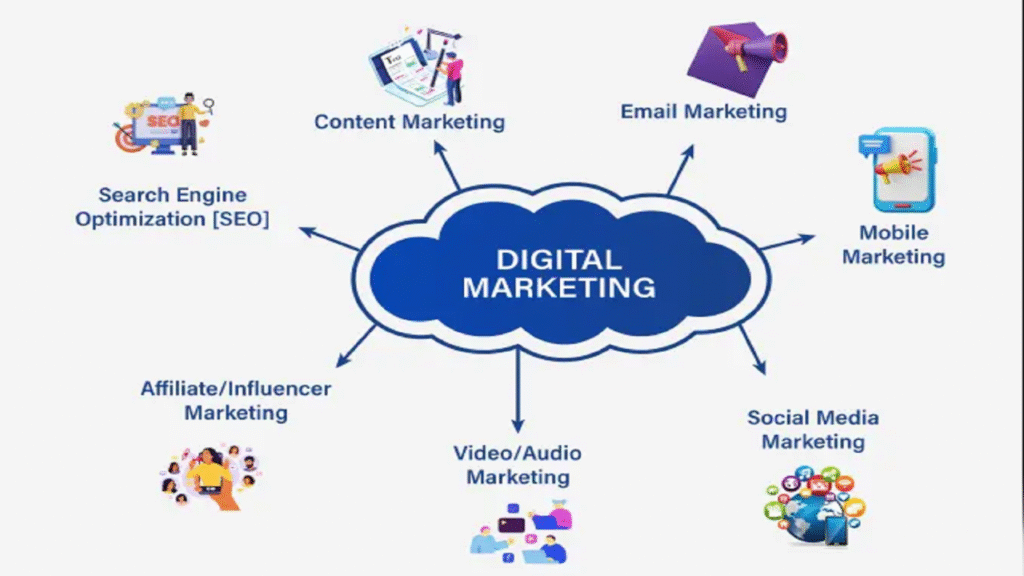
1. Search Engine Optimization (SEO)
Search Marketing starts with SEO (Search Engine Optimization). It ensures your website ranks high on search engines like Google and Bing when users search for relevant keywords.
- On-Page SEO: Optimizing content, keywords, headings, and meta tags.
- Off-Page SEO: Building backlinks and improving domain authority.
- Technical SEO: Improving site speed, mobile-friendliness, and security.
Benefits:
- Brings organic traffic
- Improves brand credibility
- Cost-effective long-term growth
SEO is a long-term investment in Digital Marketing that works alongside Content Marketing and Performance Marketing strategies.
2. Content Marketing
Content Marketing is the heart of every Online Marketing campaign. It focuses on creating valuable, informative, and engaging content that attracts and retains customers.
- Forms of Content Marketing:
- Blogs and articles
- Infographics
- Videos and podcasts
- Case studies and whitepapers
Benefits:
- Builds trust and authority
- Drives organic traffic
- Supports SEO and Social Media Marketing
In a digital-first world, businesses that invest in Content Marketing gain a competitive advantage by educating customers instead of only selling to them.
3. Pay-Per-Click Advertising (PPC)
Performance Marketing often relies on PPC (Pay-Per-Click) campaigns. Businesses pay only when users click on their ads.
- Platforms for PPC:
- Google Ads (Search Marketing)
- Bing Ads
- Social Media Ads (Facebook, Instagram, LinkedIn)
Benefits:
- Instant visibility on search engines
- High-quality leads
- Measurable ROI
Unlike traditional advertising, PPC ensures that every rupee spent contributes to actual performance.
4. Social Media Marketing (SMM)
With billions of active users, Social Media Marketing is one of the strongest pillars of Digital Marketing. It includes both organic and paid strategies to build brand awareness and engage with customers.
- Popular Platforms: Facebook, Instagram, LinkedIn, Twitter (X), TikTok, Pinterest
- Activities: Posting, running ads, influencer partnerships, contests
Benefits:
- Increases brand visibility
- Direct interaction with customers
- Enhances trust and loyalty
SMM often overlaps with Interactive Marketing since it allows real-time engagement with customers.
5. Email Marketing
Even though new channels have emerged, Email Marketing remains one of the most effective parts of Internet Marketing.
- Types of Email Campaigns:
- Newsletters
- Promotional emails
- Automated drip campaigns
- Personalized product recommendations
Benefits:
- Builds long-term relationships
- Delivers personalized experiences
- High ROI compared to other channels
Email Marketing also integrates with Web Marketing since emails usually direct customers to websites and landing pages.
6. Mobile Marketing
As more people use smartphones, Mobile Marketing has become essential. From SMS to push notifications, businesses can directly reach customers on their mobile devices.
- Forms of Mobile Marketing:
- SMS campaigns
- App-based marketing
- Mobile-friendly websites
- WhatsApp and Telegram promotions
Benefits:
- Highly personalized reach
- Real-time communication
- Affordable for small businesses
This component of Digital Marketing also supports Interactive Marketing by making customer engagement instant and direct.
7. Influencer & Affiliate Marketing
Modern Web Marketing also includes collaborations with influencers and affiliates.
- Influencer Marketing: Partnering with social media influencers to promote products.
- Affiliate Marketing: Paying commissions to partners who drive sales or leads.
Benefits:
- Expands audience reach
- Builds credibility through trusted voices
- Works well with Performance Marketing models (pay per result).
8. Analytics and Data-Driven Marketing
No Digital Marketing strategy is complete without analytics. Measuring performance is the key to growth.
- Analytics Tools: Google Analytics, Facebook Insights, SEMrush, Ahrefs
- Metrics Tracked: Traffic, engagement, conversions, ROI
Benefits:
- Helps refine campaigns
- Ensures better decision-making
- Prevents budget wastage
This connects deeply with Performance Marketing since businesses can optimize campaigns based on real-time results.
9. Interactive Marketing
Interactive Marketing makes campaigns engaging by encouraging customer participation.
- Examples: Polls, quizzes, surveys, chatbots, personalized calculators
- Platforms: Social media, websites, mobile apps
Benefits:
- Builds stronger customer relationships
- Enhances engagement rates
- Provides valuable customer insights
Interactive elements are now a must-have in Social Media Marketing and Content Marketing campaigns.
10. Conversion Rate Optimization (CRO)
Getting traffic is not enough; converting visitors into customers is the ultimate goal of Digital Marketing.
- Tactics for CRO:
- A/B testing
- Better landing page design
- Optimized calls-to-action (CTAs)
- Fast and mobile-friendly websites
Benefits:
- Maximizes ROI
- Improves user experience
- Increases sales without increasing ad spend
Conclusion
A strong Digital Marketing strategy combines multiple components—SEO, Content Marketing, Social Media Marketing, Email Marketing, Mobile Marketing, Interactive Marketing, Performance Marketing, and Web Marketing. Each plays a unique role, but when aligned together, they create a powerful ecosystem that drives business growth.
Future of Digital Marketing Trends
The world of Digital Marketing is constantly evolving. What worked a few years ago may not yield results today. Businesses need to stay ahead of trends to remain competitive in Online Marketing, Internet Marketing, Web Marketing, and Electronic Marketing. Here are the key trends shaping the future:
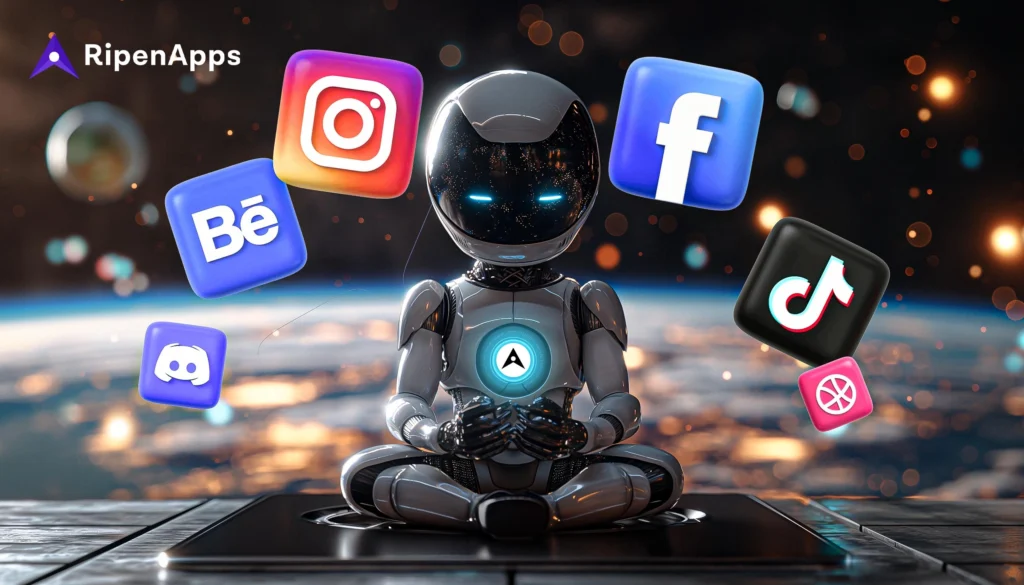
1. Artificial Intelligence (AI) in Digital Marketing
AI is revolutionizing Digital Marketing by automating tasks, predicting consumer behavior, and personalizing experiences. From chatbots to AI-powered ad campaigns, businesses can make smarter decisions.
- Applications of AI:
- Chatbots for 24/7 customer service (Interactive Marketing)
- Predictive analytics to target the right audience (Performance Marketing)
- Content generation and optimization (Content Marketing)
- Benefits:
- Saves time and resources
- Improves customer experience
- Enhances ROI
2. Voice Search Optimization
With the rise of smart speakers and virtual assistants like Alexa, Google Assistant, and Siri, Voice Search is becoming critical for Search Marketing.
- Implications for Digital Marketing:
- Businesses must optimize content for voice queries
- Conversational keywords become important
- Local businesses benefit from “near me” searches
Voice search ensures Online Marketing reaches users in new, hands-free ways.
3. Video and Interactive Content
Visual content is dominating Social Media Marketing, Content Marketing, and Web Marketing. Videos, interactive infographics, and live streaming keep audiences engaged.
- Examples:
- Instagram Reels and TikTok videos (Social Media Marketing)
- Interactive polls and quizzes (Interactive Marketing)
- Webinar sessions and product demos
- Benefits:
- Higher engagement rates
- Improved brand recall
- Supports storytelling and emotional connection
4. Personalization and Customer Experience
Modern consumers expect personalized experiences. Digital Marketing strategies are increasingly focusing on individual preferences.
- Techniques:
- Personalized emails (Email Marketing)
- Retargeting ads (Performance Marketing)
- Customized product recommendations on websites (Web Marketing)
- Benefits:
- Increases conversion rates
- Builds customer loyalty
- Enhances satisfaction and retention
5. Mobile-First Marketing
With more people accessing the internet via smartphones, Mobile Marketing is no longer optional. Mobile-first websites, app-based campaigns, and mobile-friendly content are essential.
- Benefits:
- Reaches users anytime, anywhere
- Supports social media and email campaigns
- Improves SEO and search rankings
6. Augmented Reality (AR) and Virtual Reality (VR)
AR and VR are transforming Interactive Marketing by providing immersive experiences.
- Applications:
- Virtual product try-ons for e-commerce
- AR filters on social media platforms
- Virtual showrooms and tours
- Benefits:
- Enhances customer engagement
- Creates memorable brand experiences
- Differentiates businesses in competitive markets
7. Data Privacy and Ethical Marketing
With rising concerns over privacy, regulations like GDPR are shaping Digital Marketing practices. Businesses must ensure transparency and ethical handling of customer data.
- Strategies:
- Transparent consent forms
- Secure data storage
- Ethical targeting in Performance Marketing
- Benefits:
- Builds customer trust
- Avoids legal issues
- Enhances brand credibility
8. Integration of Omnichannel Marketing
Future Digital Marketing will focus on creating seamless experiences across multiple channels: online, mobile, social, email, and offline touchpoints.
- Omnichannel Examples:
- A customer sees a Facebook ad (Social Media Marketing), receives an email reminder (Email Marketing), and finally purchases through the mobile app (Mobile Marketing)
- Benefits:
- Consistent customer journey
- Higher conversion rates
- Better brand recognition
Conclusion
The future of Digital Marketing is digital-first, AI-driven, and customer-centric. Trends like Voice Search, AI, Video Marketing, Mobile Marketing, Interactive Marketing, Performance Marketing, and Content Marketing are reshaping how businesses engage with audiences. Companies that adapt to these trends will lead in Online Marketing, Internet Marketing, and Web Marketing, ensuring sustainable growth and competitive advantage.
